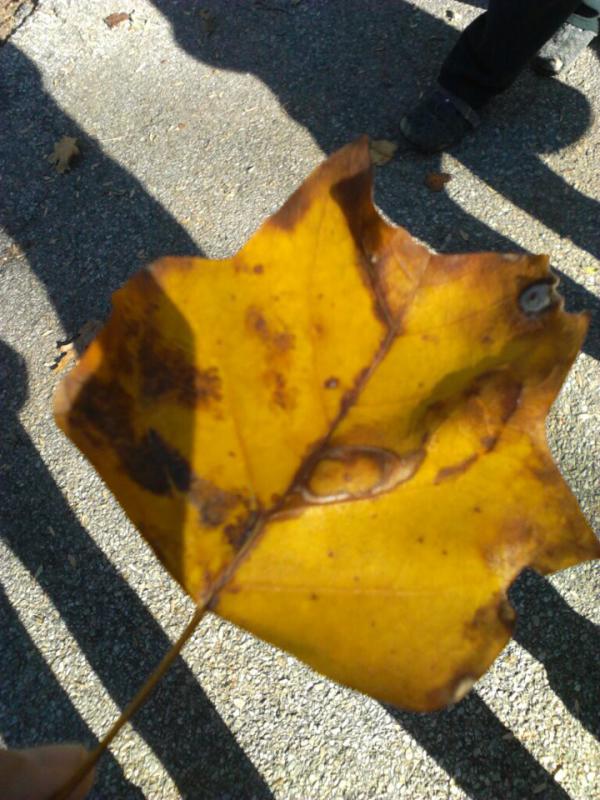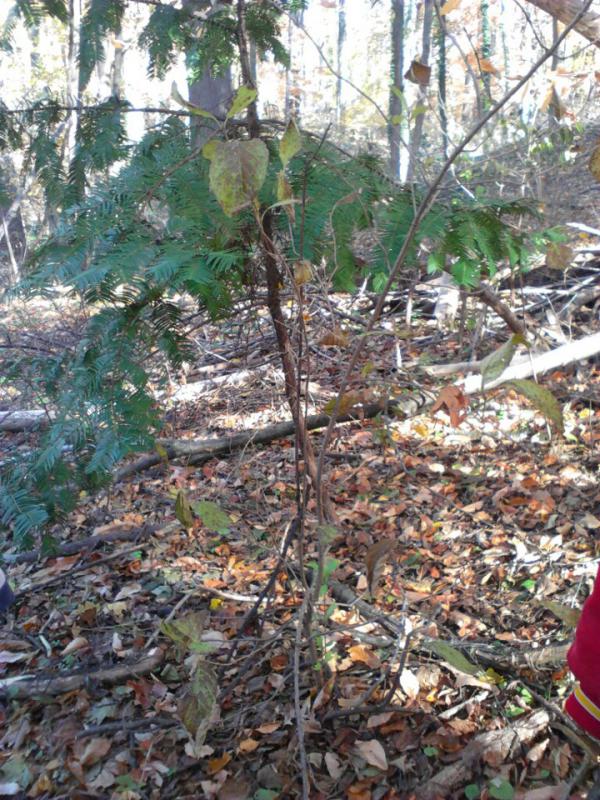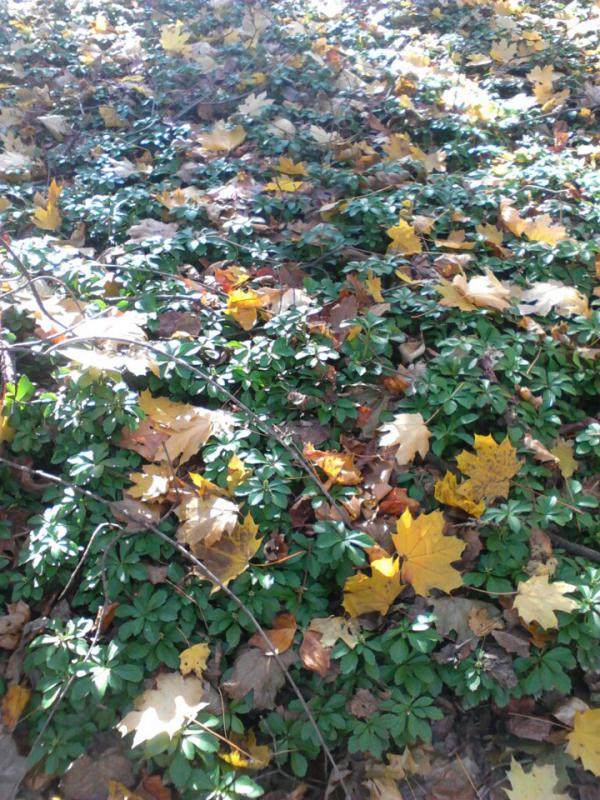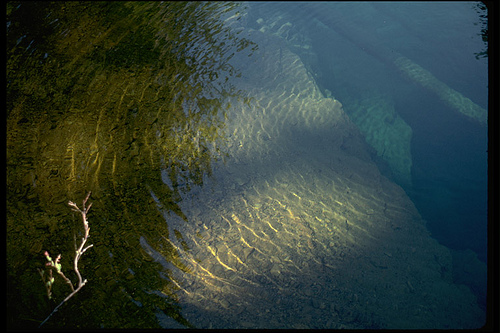Serendip is an independent site partnering with faculty at multiple colleges and universities around the world. Happy exploring!
Biological Tour!
Our biological tour was amazing, not only because of the plant species we were shown but also because I found many interesting "natural crafts" around the campus.
So, what are these plants?

This is the leaf of a yew. It is, surprisingly, slightly toxic, but its toxicity could help treat cancer if used properly.It is more dominate here than many native species and thrives at central east part of the country. Some Tulip Trees grow well around Yews.

Verbinum is the theoretically invasive plant here! Its leaves has a smell of green pepper even when they are fading in color.

The green, ignorable plants under our feet are called Pokey Sundra. There are so many of them!

The lovely Spicy Bush has a lemon smell, and they looks as yellow as lemon as well. We found some of them right next to Verbinum.
There were so many plants inside and around the campus, and it is exciting for us to learn their names!
Muddy Connections
The Sunday before Thanksgiving break, I found myself thinking about mud.
On our geological biological tour, we did not exactly follow the directions to the letter. The instructions were to spend time talking about the class, then proceed with either the geological or biological tour, and after that one was finished, go on to the next part. Our group started by talking about the class, which was interesting. It was like seeing a parallel universe Ecological Imaginings. Small things like the places we have class and the majors within the groups are different, but we are really getting the same things out of the class, a better understanding of our ecology.
After that portion of our time together, we decided to walk across campus (from Erdman where we started to Mill Creek) and whenever we saw something that was incorporated into our respective tours, stop and talk about it. I liked this. In a way it was very ecological. We didn't separate geology and botany into distinct group, but addressed them as they came in the natural flow of our sauntering.

The Self, the Other, the Silence
"Competing tendencies reside in a state of simultaneity: they are always at the same time separate and united, this and that...the Self is always at the same time both itself and other"-George Kalamaras
During our last silence exercise of our class this past week, I found myself pushing back on the silence. I found myself constantly wanting to analyze and critically think of Kalamaras' words in relation to silence. I found myself asking: "What is the goal of silence and how much of how silence is perceived, fueled by the "other" that the self "competes" with in a state of simultaneity?" I then found myself wondering whether the individual self has as much to do with how his/her silence is perceived. Can the self manipulate his/her environment in order to fuel her silence in a positive way? if so, what is necessary for this to happen?

1968 Bryn Mawr Campus Tour
Since we're having trouble uploading our Virtual Tour video, we will be posting the research so you can get an idea of what the tour will look like. I'm pretty sure we'll be showing it in class.
360 VISION RESEARCH PROJECT: 1968 TOUR OF BMC/SOCIAL CLIMATE
By Esty & Chandrea
Here is where we can start to compile our information and the resources we use!
Project focus: Campus tour/map with a focus in 1968. Perry House and Batten do not exist at that time. So we could focus on the campus and social climate for the tour--it was HOT!
Areas of interest on dorm and campus life (guide questions/FAQs on tours?):
Why don’t we have sororities?
What affinity groups existed during this time period?
What were some popular activities?
What was the most common major?
What did the campus look like?
How did customs and other dorm supports function?
What historical events coincided and/or preceded--therefore, influencing--the 60s/70s
What slang was used so we look authentic?
What do students do for fun?
What religious services are available?
Information (Jotted Notes):
General/historical/big picture context:

Religious silence
In our last class I was very struck first by our readings, and then by the last part of our class. It was the first time that I realized the difference between how Quakers and Catholics pray. When I go to church, it is usually accompanied with music, sermons, speeches, and lectures and just words in general. Words words words. Music music music. Even in silent prayer we're not silent because the priest leads us. This is very different from our practice on Thursday where we were each in charge with connecting with whatever it is that we wanted to connect with it. I find it very interesting that the Quakers sit in silence and wonder what such spiritual experience would feel like, to be in charge of making your own connection with God.
Jody's assignment
Sasha, Jomi, and I made a prezi about a timeline of the history of African American students at Bryn Mawr. We also have a physical timeline that we will bring to class Tuesday: PREZI

also some quotes
...from yesterday that I don't want to forget:
"Just because they have life doesn't mean their life stops."
"What do I get by telling others that they are stuck?"
"Nobody's homework is done."

McBride Scholars: “Finally it’s my turn and I want the best education I can have”
“Finally it’s my turn and I want the best education I can have”
In thinking about Bryn Mawr’s campus, it becomes obvious that many small communities exist within our walled community. Communities consisting of students of color, international students or students from the same area. An important community within Bryn Mawr is the Katharine E. McBride Scholars Program or McBride Scholars for short. They are women, twenty four or older, who did not complete their college education after high school for one reason or another. Bryn Mawr looks for non-traditionally aged students that exemplify intelligence, talent and achievement. These traits may be displayed through volunteer work, their jobs or some form of formal study. What separates McBride scholars from many traditionally aged students are their life experiences. Many of the women have family commitments such as children and aging parents or full time jobs. Some have put their education on a hiatus due to financial reasons or simply because of life and the tribulations it can bring along.



